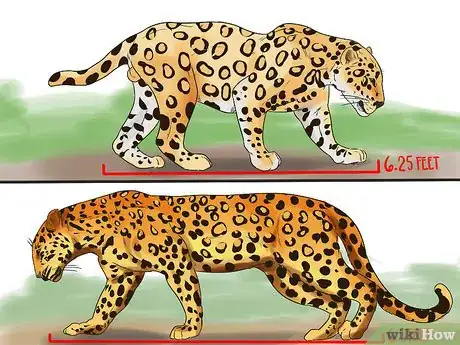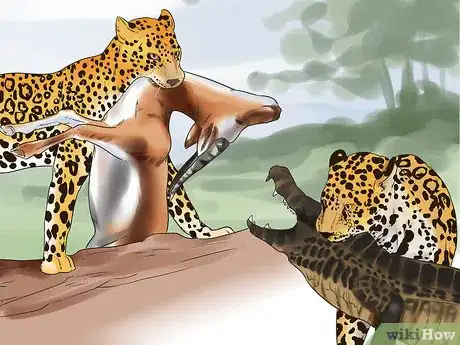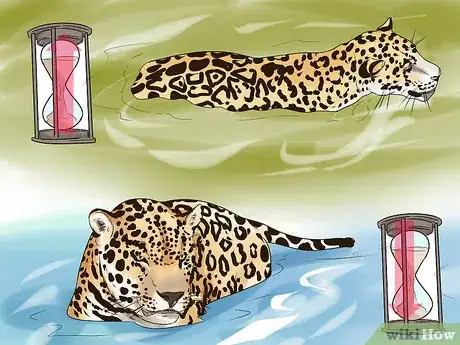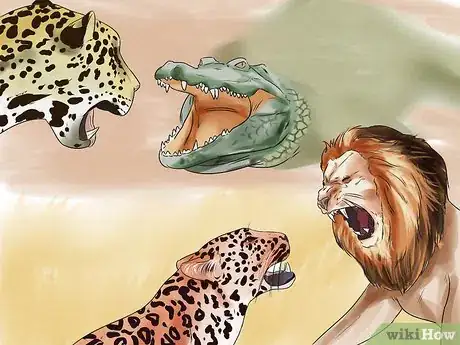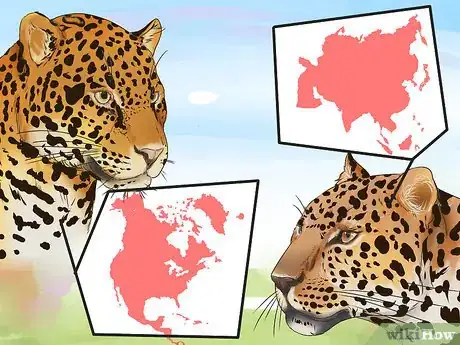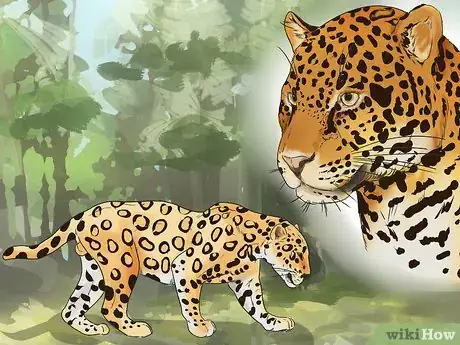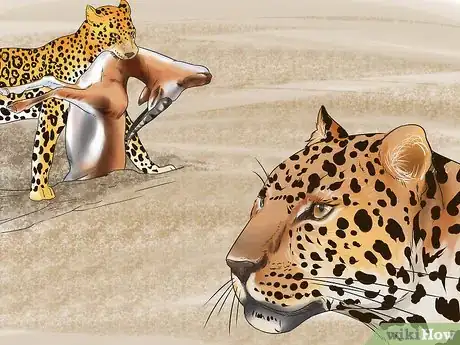This article was co-authored by wikiHow Staff. Our trained team of editors and researchers validate articles for accuracy and comprehensiveness. wikiHow's Content Management Team carefully monitors the work from our editorial staff to ensure that each article is backed by trusted research and meets our high quality standards.
There are 8 references cited in this article, which can be found at the bottom of the page.
wikiHow marks an article as reader-approved once it receives enough positive feedback. In this case, 86% of readers who voted found the article helpful, earning it our reader-approved status.
This article has been viewed 88,408 times.
Learn more...
Jaguars and leopards look very similar and are often confused. They both exhibit a tan coat with rosette patterns, and both cats have variations with all-black coats. However, these two big cats are distinguished by a number of physical, behavioral, and territorial differences.
Steps
Differentiating by Physical Appearance
-
1Compare the body sizes of the two animals. One of the biggest differences between jaguars and leopards is their physical size. Leopards are generally smaller than jaguars, though size discrepancies exist within each species.[1]
- Jaguars can grow up to 6.25 feet long (1.9 meters). Adult jaguars can weigh up to 211 pounds (96 kilos) and stand 25 to 30 inches (76 centimeters) tall at the shoulders.[2]
- Leopards can grow up to 6.3 feet (1.92 meters) in length and weigh up to 198 pounds (90 kg).[3] Leopards are taller than jaguars, with adult leopards standing up to 31 inches (78.74 centimeters) tall at the shoulders.
-
2Look at the size of each animal's head. Another physical distinction between jaguars and leopards is the size of each animal's head. Jaguars typically have much larger heads than leopards, which makes sense given the overall body size difference between these two cats.[4]Advertisement
-
3Examine the tail of the animal. The size and patterns on each animal's tail can be another distinguishing feature. The tail of a jaguar is typically shorter than the tail of a leopard. [5] A jaguar's tail patterns are also unique: the rosette patterns on the tail may appear to "merge," forming a band around the tail.
-
4Examine the coat of each animal. Though jaguars and leopards have very similar-looking coats, there are some noticeable differences between the two. Close examination of the patterns and coloration can often reveal which animal is which.[6]
- While both animals have rosette patterns on their coats, a leopard's rosettes are solid. A jaguar's coat will have spots inside the rosettes, setting it apart from those of a leopard.
- The rosettes on a jaguar's coat are usually much larger, whereas a leopard's rosettes are typically very closely-spaced together.[7]
- A jaguar's base coat color is usually a shade of yellow, but it can also be reddish-brown or even darker. The throat, outer legs, underbelly, and lower flanks are usually white (though they may have spots).
- Both animals can have an all-black coat, but a black leopard will still show a rosette pattern on its black coat. A black jaguar's coloration can also appear more like a mix of blue/black and purple.[8]
Comparing Behavioral Characteristics
-
1Check whether the animal carries prey into a tree. Leopards and jaguars are both skillful hunters, but leopards are the only known big cat that carries its dead prey into a tree. Leopards also climb/jump out of trees headfirst.
- If you witness the animal carry its prey into a tree, it is definitely a leopard. However, that doesn't necessarily mean that leopards will do this every time.
-
2Observe how the animal behaves around water. There is a distinct behavioral difference between leopards and jaguars when it comes to being in the water. Both jaguars and leopards are skilled swimmers, but jaguars will actively spend time in water, whereas leopards will generally try to avoid being in the water as much as possible.[9]
-
3Notice the way the animal fights other animals. Both cats are strong, skillful predators. However, jaguars are typically more willing than leopards to fight a larger animal species. Leopards, by contrast, will usually run away from larger creatures like lions, pythons, or even hyenas.[10]
Considering Each Animal's Habitat and Location
-
1Learn the geographic regions of each animal. While physical and behavioral characteristics are the easiest ways to distinguish between a jaguar and a leopard, you can also identify the animal by its geographic location. These two big cats naturally live on opposite sides of the world, though of course some individuals may be kept in captivity in other regions.[11]
- Jaguars live exclusively in North America, Central America, and South America, and may not be able to survive in a leopard's habitat.
- Leopards live in African and Asian countries, and may not be able to survive in a jaguar's habitat.
-
2Consider a jaguar's typical habitat. In addition to geographic location, it may also be helpful to know the animal's preferred environment. Jaguars are somewhat diverse in their habitat selection, though they typically inhabit rain forests, flooded wetlands, swamps, and dry grasslands.
-
3Know a leopard's typical habitat. Though they live on different sides of the world, leopards and jaguars often reside in similar habitats. Leopards can inhabit a broad range of habitats, including woodlands, grasslands, mountains, deserts, and rainforests. The specific habitat a leopard inhabits depends largely on which continent it resides in.[12]
Community Q&A
-
QuestionWhich animal is more powerful: a Jaguar or a Leopard?
 Community AnswerA leopard has stronger shoulders, but a jaguar has a stronger skull. It also depends on the subspecies.
Community AnswerA leopard has stronger shoulders, but a jaguar has a stronger skull. It also depends on the subspecies. -
QuestionIs a leopard bigger than a jaguar?
 Community AnswerThey're very similar in size, but the jaguar is stockier and more muscular than the leopard, with a compact body, a broader head, and powerful jaws. The jaguar's tail is also generally shorter than the leopard's tail.
Community AnswerThey're very similar in size, but the jaguar is stockier and more muscular than the leopard, with a compact body, a broader head, and powerful jaws. The jaguar's tail is also generally shorter than the leopard's tail. -
QuestionCould they cross-breed?
 Community AnswerYes. The offspring of a jaguar and a leopard is called a panthera hybrid. Often the result of a situation like this is that the offspring males are infertile.
Community AnswerYes. The offspring of a jaguar and a leopard is called a panthera hybrid. Often the result of a situation like this is that the offspring males are infertile.
Warnings
- Never approach a big cat, no matter what type of animal it is. While big cats are naturally wary of humans, they can easily kill a person if they feel threatened.⧼thumbs_response⧽
References
- ↑ http://www.wildcatsanctuary.org/the-top-5-differences-between-jaguars-and-leopards/
- ↑ http://www.defenders.org/jaguar/basic-facts
- ↑ http://ielc.libguides.com/sdzg/factsheets/leopard/characteristics
- ↑ http://www.bigcats.com/learn-to-identify-the-big-cats
- ↑ http://www.wildcatsanctuary.org/the-top-5-differences-between-jaguars-and-leopards/
- ↑ http://bigcatrescue.org/jaguar-facts/
- ↑ http://www.bigcats.com/learn-to-identify-the-big-cats
- ↑ http://bigcatrescue.org/black-panthers/
- ↑ http://www.wildcatsanctuary.org/the-top-5-differences-between-jaguars-and-leopards/
About This Article
To tell a jaguar from a leopard, start by comparing their body sizes, since leopards are usually smaller than jaguars. Jaguars typically have much larger heads than leopards, and their tails are shorter. Both cats feature coats with rosette patterns, but only a jaguar will show rosettes that merge and form a band around the tail. A jaguar's coat will also have spots inside the rosettes, whereas the leopard's rosettes are spaced closely together and don't have spots. For tips on considering behavior and geographical location, read on!
